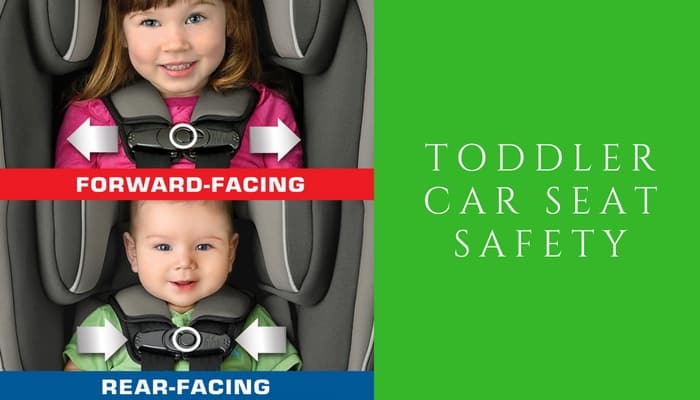
I think you will agree with me when I say that once that sweet little child becomes a toddler, strapping them in and keeping them strapped in becomes so much harder.
Why you ask?
Well at this age the child is very much interested in a lot of things and will not be shy to reach out for them or let you know that they want to get out of that constricting car seat.
This can make for quite for some stressful trip, even if it is just a short trip to the store to get some milk.
Nonetheless, while a toddler can be quite a handful, you can still keep them safe in their car seat by following the following tips and recommendations.
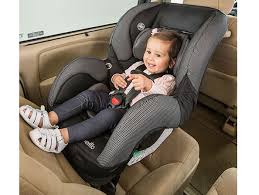
With some studies showing that up to 90 percent of car seats are installed incorrectly, infant car seat safety is an important consideration when using car seats.
According to some estimates, most car crashes will happen at very short distances from the home, typically less than 25 miles.
To add on to that, these crashes will not happen on the major highways, meaning that even that short drive to grab some groceries could potentially be fatal.
Using the car seat can be quite tricky especially if you are a first-time mother, given that some child safety seat installation instructions are complex.
Moreover, given that the child usually has delicate features and other peculiarities such as a large than normal head, proper installation and use of a car seat are paramount.
Types of Toddler Car Seats
When it comes to your kid’s toys, clothes, or the paint in their nursery, how cute they make the room or kid look will come into consideration. However, when it comes to car seats, it is more important that you take into consideration of safety rather than beauty. The following are some of the toddler car seats to use with your baby. It is important to note that a good toddler car seat needs to have a 5 point harness for enhanced safety.
- Best 3 in 1 (All in one) Similar to the common convertible car seat, these seats can be used as rear-facing car seats then transition to forward-facing car seats and lastly into boosters. Given its typically bigger size, it is important to consult the manufacturer manual prior to buying to ensure it is a good fit for your vehicle.
- Infant Car Seat – This is a small car seat that has the advantages of being portable and lightweight and could also be part of a travel system when combined with a stroller. It has a base that you do not have to lug around while the shell has a handle allowing you to carry the child around or put it in a stroller. Designed for use for babies weighing in at 22 to 40 pounds, you should only install and use it in the rear-facing mode. Your child will typically exceed the weight and height limits of the infant car seat between 9 months and a year thus necessitating the shift to an all-in-one or a convertible car seat.
- Best Convertible car seat – Most convertible car seats can be used in the forward and rear facing mode. While they are heavier than infant car seats they do not come with bases or carrier handles. Given that they can be used in rear and front-facing mode, these seats can accommodate a toddler up to between 40 to 50 pounds making them a good option for your big toddler.
- Best Rear Facing Car Seat – These types of car seats include combination and infant car seats that can accommodate children from 5 pounds up to about a year old for infant seats and up to 12 years for the best combination car seats.
You will also need to check for the type of harness used. The 5 point harness is always a good option since it ensures the child is snugger thus keeping them safer.
Luckily most new car seats come with 5 point harnesses. With five points of attachment: one between the baby’s legs, two at either side of the baby’s hips, and two above the shoulder.
The three-point harness only has one between the baby;’s legs and two above the shoulders of the infant.
How to Use a Toddler Car Seat
What Makes for a Good Infant Car Seat Fit
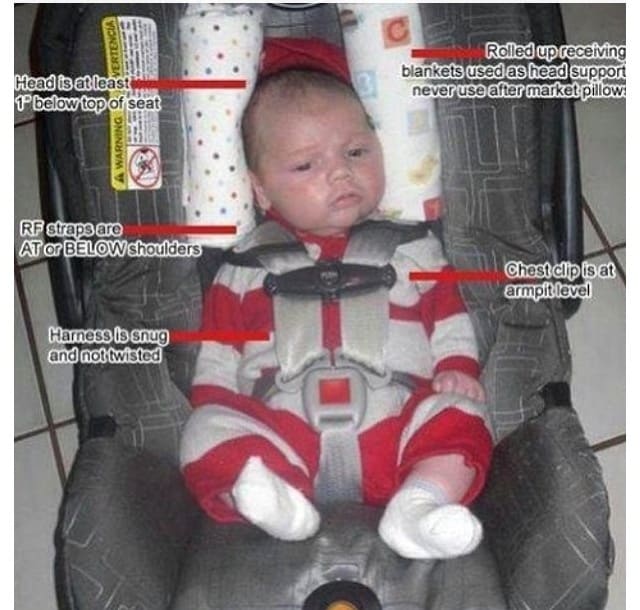
- Short Crotch Buckle – Given that the infant is tiny, you often find that the crotch buckle is too long making it difficult to fit in the crotch buckle and the chest clip. The best way to avoid this is to go for car seats that allow J-Looping of the crotch buckle to make for a better fit for your preemie.
- Close Crotch Buckle Position – To prevent any slouching you need to make sure that the crotch buckle is as close as possible to the baby body. Slouching can be dangerous as it interferes with the kid’s natural breathing.
- Low First Shoulder Strap Slot – Always make sure that the straps are as near as possible to the shoulders. The recommended position is typically at or just below the shoulder level.
When to Shift to a Forward Facing Car Seat
As I have always said, it is always advisable to keep the child in the rear-facing mode until they are at least two years old. If you can keep them there for longer, you should definitely do it until they reach the maximum weight recommended for the given seat. What makes the rear-facing car seat so safe for toddlers and babies is that they offer much-needed support for the kid’s spine, neck, and head-protecting them from whiplash injuries in the instance of a crash.
When to Switch from Latch to Seat Belt
Since 2002, the NHTSA has required that all passenger vehicles come with Lower Anchors and Tethers for Children (LATCH). LATCH is safer than the conventional seat belts whose installation was not as standardized or as safe. LATCH comes with a tether that you can easily attach to the car seat and anchor it on an anchor point inbuilt on the vehicle seat. Check your car seat and vehicle owners manual for instructions on how to use the LATCH system. If your car was manufactured before 2002, you can still use seat belts as long as you ensure the installation is as safe as possible. While LATCH is the safest way of installing a child safety seat, the NHTSA recommends that for kids above age 3, you should switch to seat belts as the LATCH anchors are not strong enough to take the weight of the child and the seat in the instance of a crash. As such it is important to check the age and weight limit of the car seat to ensure that your toddler is safe when using LATCH.
Toddlers and Booster Seats
While it can be very tempting to transition the child to a booster car seat, I would not advise that a toddler ride in a booster seat. A toddler in this instance means any child younger than 4 years old. For the child younger than 4, they need to be riding in a car seat with a five-point harness typically a convertible, combination, or all in one until they attain or outgrow the forward-facing car seat weight and height limits.
Even when the child attains that age, ensure their safety by transitioning them using belt-positioning booster seats. If you are using an all in one car seat, you can transition it to a booster seat. You can only transition the child to seat belts when they are about 4 foot 9 in height and about 80 pounds typically at about 12 years of age.
Toddler Car Seat Safety for Toddlers
- Review Car Seat Safety Guidelines – You can have the right toddler car seat but if the child is not strapped in properly or you do not know how to use the safety seat, your child will not ride safely. Even if you have been using car seats for a very long time, it is still very critical to check out manufacturer recommendations, car seat safety tips, and vehicle manuals to ensure the child is safe. Always install the car seat in the backseat of the car and for even better install it in the middle of the seat.
- Ensure a Professional Inspects the New Car Seat – Always find a certified car seat inspection technician to inspect the car seat and the installation before you start using it. You can find an inspector for your car seat here.
- Check for Harness Fit – For utmost safety, check that the harness straps are below or at the child’s shoulders with the top of the chest clip at the level of the toddler’s armpits. for a snug tight fit, you should get no more than two fingers between the child’s body and the harness strap.
- Do not Dress the Kid in Bulky Clothing – Bulky clothing makes the harness straps fit poorly on the child’s body. As such you need to avoid any bulky snowsuits, winter jackets, or any other clothing that adds an extra layer between the strap and the baby. If you think it is too cold, you can protect the child from the cold by laying a blanket over them or using a suitable sweater.
- Keep Little Arms and Fingers Safe – Toddlers being toddlers get bored and start playing with push-button operated windows. To keep the child safe ensure the windows are locked and controlled from the driver’s seat. Give the child some toys or books to play with to reduce the temptation of playing with windows.
- Tether Toys – At an age when your kids want to always be doing things, having to sit still in a car seat for even five minutes can be incredibly boring for them. To ensure that your child is never bored give them some safe toys which you can attach to the car seat. Ensure that the toys are not anything sharp or one that they can hurl at you or harm themselves with.
- Do not Leave the Kid in the Car – With research showing that can heat or cool down at up to twenty degrees in 10 minutes, any child younger than 4 can be in grave danger from heat or cold if you leave them in the car given their large surface area to volume ratios. To ensure you do not leave the child in the car always put something important there such a briefcase o purse so that you would have to check in there before leaving.
- Use the Car Seat Only for Travel – Car seats are not made for any use outside of travel. While a car seat makes the child safe while traveling, allowing the child to snooze in the child safety seat can be very dangerous and could result to severe causes such as suffocation or strangulation.
Get the Car Seat Installation Checked by a Technician
As such it is critical to check that your installation is up to speed. You can always find an expert to check your handiwork at the following places:
- Call 866-SEAT-CHECK or find a seat inspection center by looking it up in the NHTSA directory
- Enquire at the local fire or police station, car dealership or baby store which will in most instances perform the car seat safety check for you for free.
- Given that a car seat safety technician usually has the latest on the use and installation of a car seat, you can consult one by looking them up on the National Child Passenger Safety Certification Program website.
Buckling the Baby Into the Car Seat
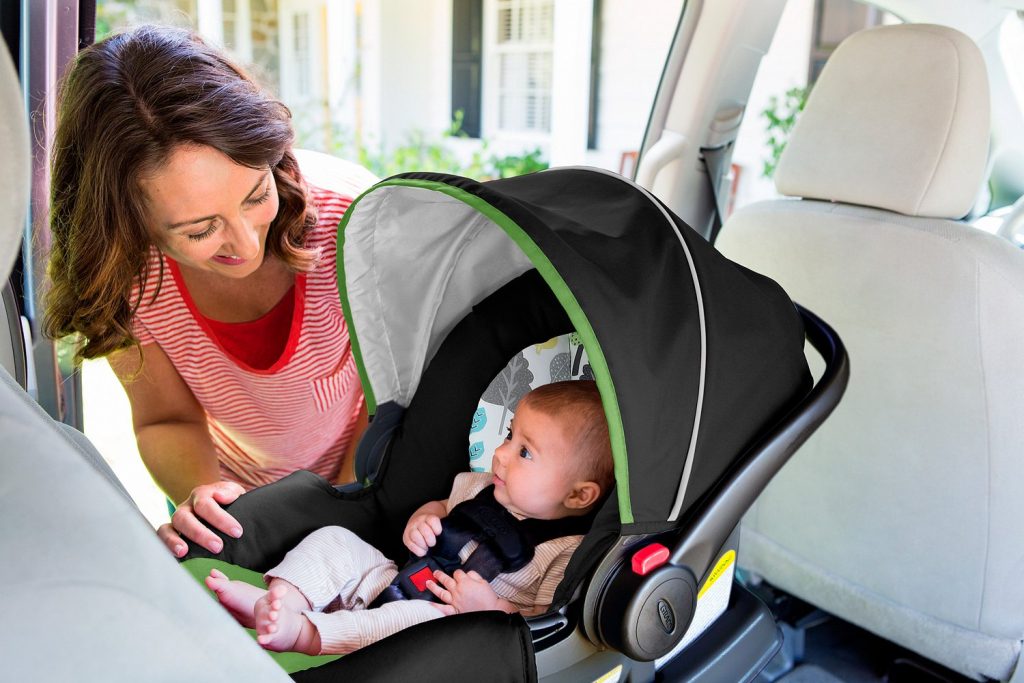
When you are ready to get on the road it is critical t keep the following in mind:
- Dress the newborn in appropriate clothes – Given that the harness straps pass between the legs of your baby, it is critical to take this into account and dress them appropriately. Tights, leggings, or pants come in handy in ensuring a tight yet comfortable for the kid.
- Install the seat at a 45-degree angle – too flat an installation and the kid could slip right through the harness while too upright and their head will flop onto their chest making them uncomfortable and breathing difficult. Check the angle indicators of your car seat to ensure the seat is installed at the right angle.
- For more protection to the child’s head especially if they are younger than 6 months you want to use the inserts that come with the seat or pad the sides with a tightly rolled blanket to prevent the child heads from bobbing and flopping during the journey. NOTE: Do not use a head support device or accessory that did not come with the car seat as they are not safe and will void the warranty on your car seat.
- Adjust the Harness – Most parents will use the harness as is which is a big mistake as children come in different sizes. Ensure that the straps are below or at your kids’ armpits for maximum safety. Ensure that the straps are untwisted and lay flat and are tight enough as not to let you insert more than two fingers between the baby’s collarbone and the harness.
- Get them some toys – Trust me you do not want a child screaming in the backseat when you are driving. Be sure to attach some toys to the seat that the child can play with short cords or plastic links. Alternatively, get them some activity centers that are sure to keep them occupied for a long time allowing you to concentrate on your driving.
How to Calm Down a Crying Infant in a Car Seat
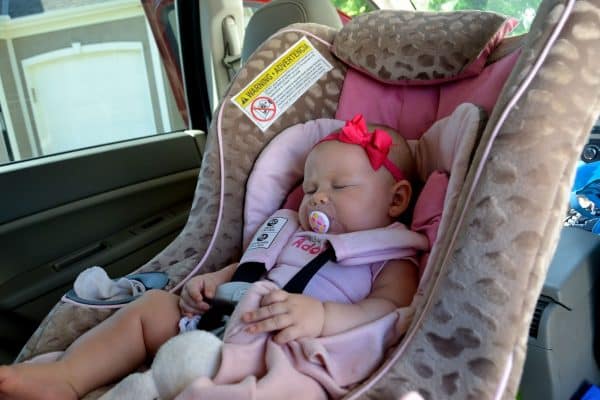
If you have had your preemie cry when you put them in their infant car seat, you are not alone.
Most infants will typically cry when you dress, change his diaper or put him in the car seat.
In this regard Dr. Harvey Karp, the author of The Happiest Baby on the Block herself a pediatrician recommends the following to calm down a child in their car seat.
- Sucking – This is the most powerful technique for calming down a child – once the child is in the car seat, give them a pacifier to calm them down – works almost instantly.
- Swinging – A newborn has been used to the swinging motion of the mother while she was in the uterus. Preemies will therefore have a hard time adjusting to the motion not being there. You can simulate this motion by swinging the car seat gently by the handle until they are calm before bucking them in.
- Shushing Sounds – Babies in the uterus usually experience constant white noise from the blood moving around the mother’s body. You can simulate this calming soundtrack by making a loud shushing noise to calm down the newborn.
- Swaddling – The baby will typically spend the last months of their time in the womb in a fetal position with constant support and touch from the uterine walls. To mimic this constant touch roll up blankets and place them alongside the baby to provide the calming touch that they crave.
The Picture Guide To Car Seat Safety [Tips and Tricks]
I’ve written a ton about car seat safety. Many people do. You often hear statements like this device is the only device you absolutely have to buy for a baby or your child can die.
You can rig random things to function as child-proofing at home or pick up things from a garage sale, but when it comes to your car seat, it HAS to be new, it HAS to be good quality, it HAS to be the right seat for your child and you HAVE to use it right or your child can DIE.
I don’t know that I can make it any clearer than that.
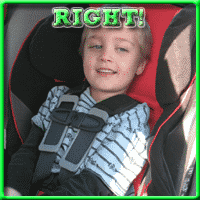
Now, don’t get me wrong — I made my fair share of mistakes, and continued to make some for years, but kept improving.
I have no problems with people who intend to learn and do better as they know more. It’s admirable, and it’s the best anyone can ask for.
Whether or not you feel this post is helpful for you, please share it so that maybe it can get to people who can benefit, or more, whose children will benefit, possibly making the difference between life and death.
And without further ado, here’s my picture guide to best convertible car seat safety, in DOs and DON’Ts.
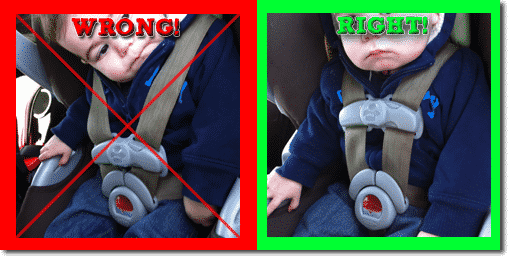
Chest Clip: The name is self-explanatory, so I thought. It belongs between the armpit and the nipple level. Nowhere else, ever.
Risk: The clip on the belly can damage internal organs and doesn’t hold the straps properly over the chest as they’re designed to do, meaning your child could be ejected from their seat.
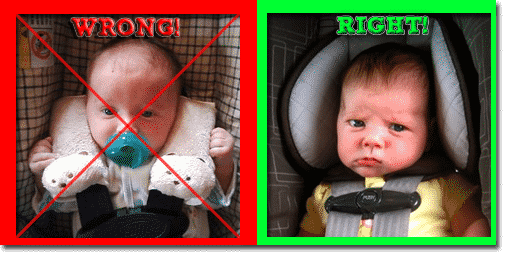
Aftermarket Products: Do not use anything on your seat that did not come with it.
Risk: Aside from voiding your warranty, all manufacturer liability, and being denied a replacement seat in a crash, things added can damage the straps or interfere with the function of the seat.
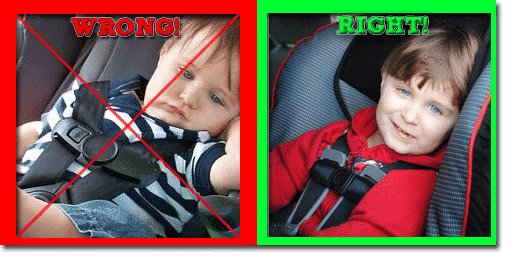
Harness Straps: Straps need to be about as tight as you can get them without hurting the child. Try The Pinch Test each time you buckle your kiddo in, just to be sure.
Risk: Loose straps do not hold the child in the seat. They can be partially ejected, which can damage any part of their body that is caught, or totally ejected and fly into the window, seats, another person, or out of the car entirely. This is the most common mistake.
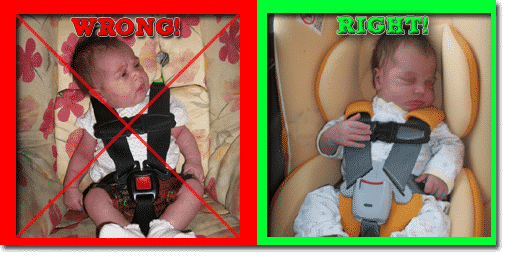
Harness Height: For rear-facing, the straps must be AT OR BELOW the shoulders. For forward-facing, AT OR ABOVE. You may put a popsicle stick or butter knife in the slot to test since sometimes the covers can make it hard to tell where the slot is in the shell.
Risk: When rear-facing, any additional space above the shoulders works similarly to having a loose harness — it’s dangerous extra room.
Also, when hit head-on (as with 79%) of accidents, you want to prevent the child’s body from flying upwards against the back of the seat, but instead allow the seat to take the impact.
Only having the straps below the shoulders keeps the child safely in place.

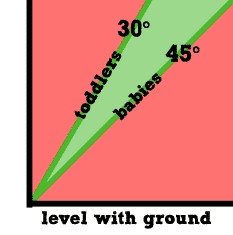
Angle: The seat needs to be reclined between a 30-45 degree angle. Once children are older and have better neck control, they can be at up to a 30 degree angle.
When switching from an infant car seat to a convertible, this change in angle can allow a convertible to take up LESS room than the infant seat, debunking the “I can’t rear-face in my car” myth.
If you can fit an infant seat rear-facing, a convertible fits too.
Risk: Even with the safest convertible car seat, if it is too upright, the body can’t slide along at the intended angle, and in smaller babies without sufficient head control that results in the head dropping down onto the chest, this could restrict breathing.
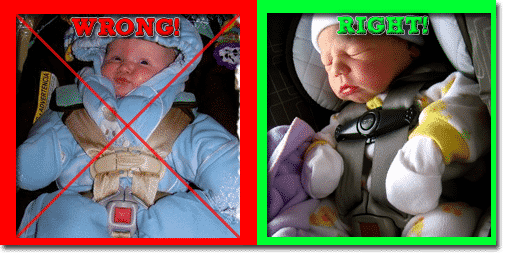
Bulky Clothes : Children should be dressed in warm-but-thin clothing, then buckled in their seat, and then have warm layers placed on top of them. (See my video here.)
Risk: In an accident, all the air in bulky clothing compresses, like a “Space Saver” bag, leaving the harness incredibly loose and putting the child at risk to be ejected from the seat.
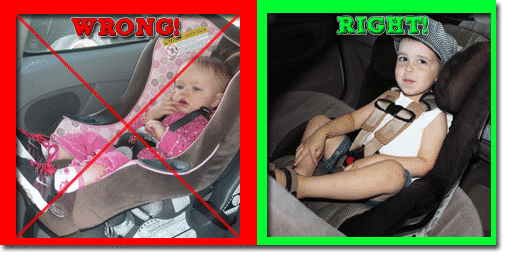
Rear-facing: Children should remain rear-facing in their car seat until they outgrow it by weight or height (less than an inch of headroom from the top of the shell).
Two years is the youngest any child should be forward-facing. Children bend their legs, even as they get older.
Risk: Babies and toddlers have weak spines that haven’t fused to protect the spinal cord, and they have proportionately huge heads, and when forward-facing, the weight of the large head pulls on the weak spine, and can separate the skull from the spine, possibly severing the spinal cord (internal decapitation), resulting in paralysis or death.
Also, the way the body slides when rear-facing helps the car and car seat absorb the maximum amount of centrifugal force so your baby’s body doesn’t have to — children are 75% less likely to die when rear-facing.
Everyone is, actually, but it’s just not possible for adults. As far as their legs? Not only would leg breaks be preferable to a broken neck, but forward-facing children are more likely to break their legs than rear-facing children.
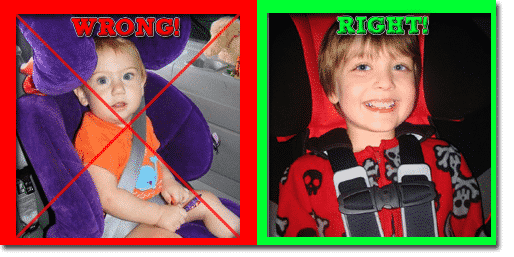
Harnessing: Safe Kids and the American Academy of Pediatrics, amongst many car seat manufacturers, recommend you keep your child forward-facing in a 5-point harness until the limits of their seats.
In many newer seats, this ranges from 50-85 pounds. 4 years and 40 pounds is the bare minimum, but most children are not mature enough until they’re 5-7 years old.
Risk: A child who isn’t big enough for a booster can slide out under the belt, called “submarining”, can have the belt sit on their belly or neck and cause internal damage to the gut or the esophagus and trachea.
A child who will not sit upright, with the belt over their hip bones and over their collar bone, or tries to put their arm over the belt or the shoulder belt behind their back is not mature enough to sit in a booster.
A child who constantly falls asleep in the car should also be in a harness or they can be seriously injured in a crash.
There’s some debate that heavier (60-70 pound+) children may be safer in a seat belt, but currently, the recommendation is still to wait until they outgrow their harness.
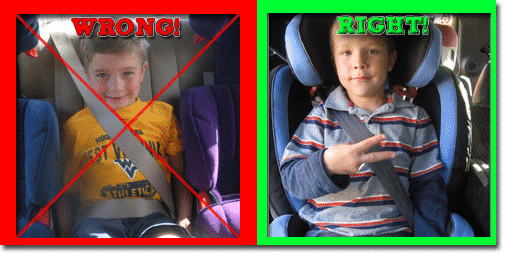
Booster Seats: Children need booster seats until they’re 8-12 years old, AND 4’9? and preferably also 80-100 pounds. Seat belts are designed to fit the average adult — not children of any age.
The strap cannot touch their necks and the lap belt should be across the hip bones, not the soft belly.
Risk: Children who are not large enough risk many things similar to putting a child in a booster too early — damage to their internal organs, throat and windpipe and the entire body in general.
Not to mention, children moved prematurely out of boosters are often quite uncomfortable!
Kids must meet the 5-Step-Test before they can go without a booster, something most children don’t meet until closer to 10-12.
Conclusion
There’s just so much to proper car seat use that I couldn’t possibly cover it here, and it’s OKAY if you’ve got something wrong. We all have screwed up at some point.
Everyone who helped me with pictures for this post was aware of what I was doing, and some of the “wrong” photos are staged — but some are not.
Some are from before moms learned and improved. It’s not a problem if you make mistakes… when it becomes a problem is when you’d rather be right than DO right, at the cost of your child’s life.
Related Reads: Most comfortable Backless Booster Seat, What Should Baby Wear Home From Hospital in Winter?
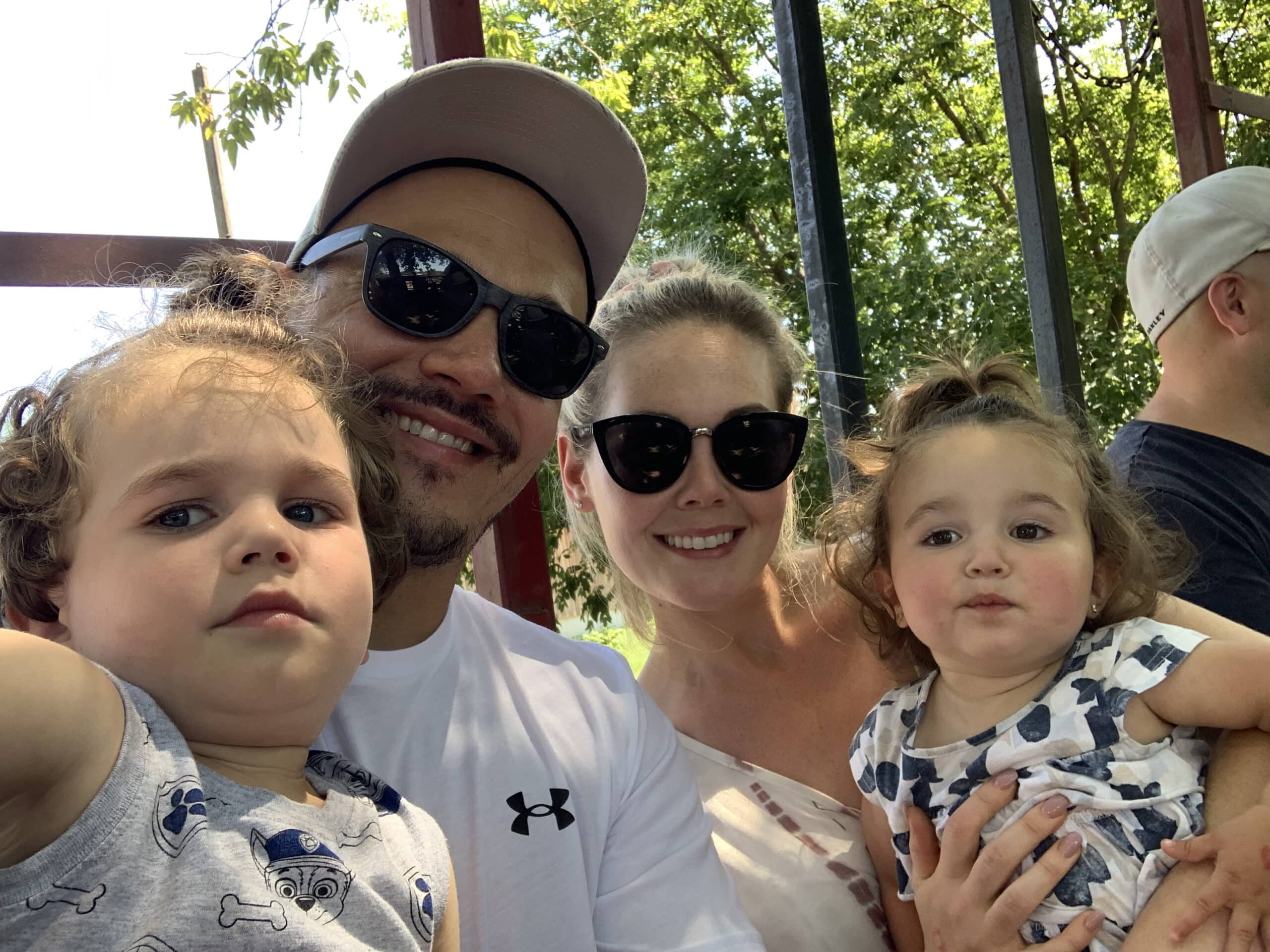
Steph is a passionate mom who co-founded Wumblers to share her parenting journey with others. She graduated from Concordia University with a masters degree in Education Technology and worked as an advisor for many years. Steph loves being a mom and wants to have more kids.
Learn more about Steph and Wumblers here.